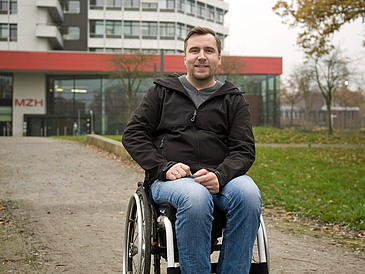Dr. Benjamin Tannert, “Benny” to his friends, shows what he can do. The likeable young man briskly gets up from his wheelchair. Staggering a little, he holds on to the table top. Only very briefly, then the computer scientist sits down again. The physical effort is visible. The 34-year-old had to train long hours with energy and resolve before he could do this. Immediately following his accident in 2005 and restricted to a hospital bed he was only able to cautiously move one of his toes. He never gave up, though, and has since come a long way.
Simplifying ways
For half a year now, Benjamin Tannert has been working as a postdoc in the geoinformatics group “Human-Computer Interaction” led by Lichtenberg Professor Johannes Schöning. Navigation is the main topic of this research group in the Faculty of Mathematics / Computer Science at the University of Bremen. The members of the group basically do research on how mobile devices can be improved on. Benjamin Tannert's topic is wheelchair navigation: He is developing algorithms that can simplify moving from A to B for people in wheelchairs.
Right of way cut off: Paralysis
The computer scientist is a native of Bremen. Raised in the Bremen suburb Vahr, he obtained his high school diploma from KSA, today the Oberschule an der Kurt-Schumacher-Allee. “I loved computer science and it was the only subject I wanted to study,” he says. In 2003 he started at the University of Bremen. Studies went smoothly and he was happy the way things were going. Until one day in June 2005 when a drunk driver violated the young motorcyclist’s right of way. Benjamin Tannert speaks calmly about his paraplegia, about future diagnoses and expectations.
“Friends had to carry me up the steps”
He became a private patient of a special clinic in Hamburg, where he made use of all the therapy and training opportunities on offer. “What motivated me? I realized I can still get a degree in computer science even if I’m sitting in a wheelchair. I didn’t have to worry about that,” he says. In wouldn’t be so easy in other professions. Benjamin Tannert managed to be away only during the semester break. “By the beginning of the winter semester in the middle of October, I was back,” he says with a hint of triumph in his voice. “My family has always supported me, and my friends had to carry me up the steps,” he recalls.
Assistance systems for people with handicaps
In 2010 he was awarded his degree and developed a learning system for children with mental disabilities. “It provides support in coping with everyday school life. As for the topic, It was easy to put myself in the shoes of someone limitations,” he emphasizes. His scientific interest centered on this target group from then on. “It became the basic idea behind all my projects.” He worked on his Ph.D. on an “emotion-sensitive assistance system for people with learning difficulties” in close cooperation with Martinshof Bremen, a private foundation that supports handicapped people. And funding during this time came from the pilot program Inklusion in der Wissenschaft (Inclusion in the scientific community), which was launched at the University of Bremen.
Analyzing barriers to free movement
Together with master students, he is currently comparing ways for wheelchair users with those for pedestrians. “Google Maps does not offer that, but there are platforms like Open Route Service or Routino. They also take barriers into account.” What are the main challenges for wheelchair users? “Surfaces like sand or humpy pavements, gradients, and curbs that are not lowered,” the researcher could continue the list. An example: “I love going to the Bremer Freimarkt, but the cobblestone pavement where it takes place makes it difficult for me in a wheelchair.” Now, he wants to find out which routes people in wheelchairs use the most and has contacted the planning offices in 15 major German cities as well as the Federal Office or Statistics for information. The answer: “We do not know, but would like to have such information.”
“Take a different intersection light”
A good starting point to investigate busy routes are washrooms for handicapped people and points of interest within a radius of two kilometers featured in interactive maps. The next step will be a panoramic 360-degree camera, which Benjamin Tannert will attach to his wheelchair. Using an image recognition system, he intends to record obstacles in a similar way as Google Street View. Then he wants to develop an automatic algorithm capable of evaluating the images. The information will then flow into navigation systems. “They will then be able to say, for example, take a different intersection light, at the next one the curb is not lowered.” Benjamin Tannert has given himself three years to work on this topic. “I’m doing something constructive for people who live with limitations. That’s especially satisfying for me”, he says.

